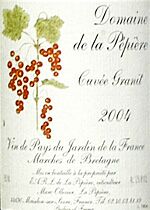|
This article was published in The 30 Second Wine Advisor on Friday, Sept. 30, 2005. Corked what? You'll recall my periodic rants about cork taint, the unpredictable fungal infection that afflicts about 5 percent of wines stoppered with natural cork with the stench of a wet basement that's been ineffectively wiped down with Clorox. It's this all-too-consistent failure rate that prompts many wine enthusiasts to cheer the gradual move away from natural cork to more sanitary closures despite a strong rear-guard action from traditionalists ... and the cork industry. But it's not always about wine. Dining out last night, I encountered 2,4,6-tricloroanisole (the jawbreaking chemical name for the stinky compound that seeps into wine on contact with a fungus-infected cork) in a completely unexpected setting. My wine was fine, but something seemed strangely funky about the salad. An odd, earthy, vaguely dirty smell was way out of place in an otherwise outstanding dish. Suddenly it hit me ... the doggone salad was corked! Unquestionably TCA-afflicted, it had that unmistakeable dank, wet-cardboard and chlorine scent for sure. But how in the heck could a salad be corked? Then the light bulb popped on: Balsamic! Balsamic vinegar from a cork-stoppered bottle! I pushed away the plate, shaking my head. I know all the arguments on behalf of natural cork. I've even preached one or two of them. But the more the evidence mounts, the more clear the reality becomes: The price we pay for natural cork is a failure rate that consumers would not tolerate in any other product. I'm not sure why we accept it in wine. Or, for that matter, in salad.
One of the most obscure wines I've tried lately, this offbeat but intriguing red blend from Marc Ollivier comes from the Muscadet region at the mouth of the Loire River, but it can't carry the name "Muscadet" because that's reserved by law for whites. Dark garnet in color, it's appealing and subtle, red-berry fruit and white pepper on the nose and palate, framed by stony minerality and mouth-watering acidity. Tangy red fruit, pepper and green tannins linger in a long finish. A varying blend of Loire red grapes that may include Cabernet Franc, Malbec (called "Cot" in the Loire), Gamay and Merlot. U.S. importer: LDM Wines Inc., NYC; Louis/Dressner Selections. (Aug. 28, 2005) FOOD MATCH: It would go nicely with salmon or other oily fish or grilled chicken, and made an excellent match with a simple omelet stuffed with Gruyère cheese. VALUE: The light, "green" and minerally style of Loire reds isn't for everyone, but if you like it as much as I do, you won't hesitate to grab this one for this price. WHEN TO DRINK: Drink up within the next year, don't cellar.
WEB LINK:
FIND THIS WINE ONLINE:
Find prices and vendors for Domaine de la Pepière on Wine-Searcher.com:
|
 Domaine de la Pepière 2004 "Cuvée Granit" Vin de Pays du Jardin de la France Marches de Bretagne ($9.99)
Domaine de la Pepière 2004 "Cuvée Granit" Vin de Pays du Jardin de la France Marches de Bretagne ($9.99)